#they really hammered in “text-to-” comparisons in elementary
Explore tagged Tumblr posts
Text
GUYS do you remember THIS post???
Well. Do I have a story for you.
When I was a wee young lass, I was on the Pony side of doll enjoyers. This was like 2008, so it was G3. I had several DVDs of the cartoon, but I had one of a live performance called "The World's Biggest Tea Party." It's exactly what you expect.
One day, I decide to go through all of my DVDs and re watch some that I haven't in a while, this being one of them. It's barely reaching feature film length, but the pacing makes it feel like it's well over an hour.
But I'm not here to critique an Mlp musical meant for 5 year olds, I'm here to show you where part of my Sister Location synesthesia probably comes from.
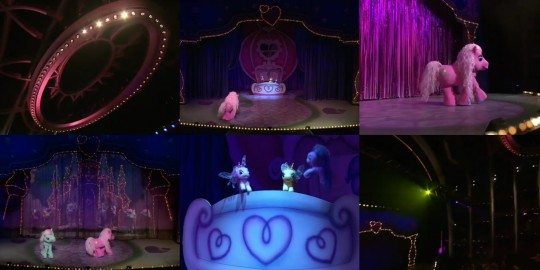
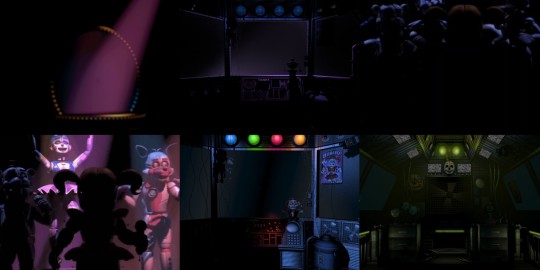
LOOK.
It was hard to find exact visual parallels, because like I said in the linked post, pink light is used when the Funtimes are preforming, which you see very little of in-game.
There were even similar plot concepts!!! Don't be alarmed, it's not what you think!!!
The movie is available for free on YouTube, but I'll summarize it since the dragging was stronger than my nostalgia goggles.
Pinkie Pie wants to plan an event with her friends where they "have the most fun in one day." So the whole movie is them preparing for a tea party that happens at their friend's house outside of PonyVille. Subplot with Spike trying to find a "how-to" book and the Ladybugs trolling him. Pinkie was so focused on making sure her friends didn't forget their responsibilities, that by the time they got there, she realized she forgot the tea. She feels super bad, but some encouragement from Minty and the screaming child audience summons an oversize teapot. Happy ending.
Text-to-text comparisons I drew:
Main character is a shade of red, and likes parties.
"The most fun in one day"
Main character being overly aware of what everyone else is doing. Super attentive, or if exaggerated, you could call it being bossy.
Main character has a big oopsie.
One of the ponies who is SO adhd coded keeps subconsciously putting off preparing her decorations. She "just wants to have fun." (Character does a thing, doesn't know why, only wants fun.)
Giant kitchen utensil.
The Ladybugs and Minireenas. They share similar design features, and pester a character associated with the color purple.
Those three fairy ponies? Bidybabs. Ones of em's even yellow, it can be Electrobab.
"Bounce Back-Ability"/Adapting from the oopsie.
The aforementioned synesthesia was all visual. I hardly remembered anything of the plot until I watched it recently. I wanna say the last time I put that DVD in, I was like 6. So like the synesthesia was coming from a near 14 year old memory. That's nuts.
#they really hammered in “text-to-” comparisons in elementary#I could pull a pear off an apple tree because the tree bears fruit#this is where i get “squink” from#you squeeze your eyes shut and think#like brainstorming but funnier#fnaf#five nights at freddy's#sister location#masq squinks
55 notes
·
View notes
Text
Oregon Trail II: The Sequel that Nobody Asked For
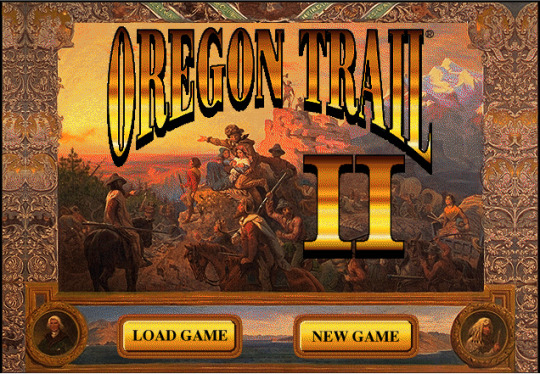
Of all the games that did not need a sequel, The Oregon Trail has got to be darned near the top of the list. While the trail blazing (pun intended) edutainment blockbuster conflates numerous journeys across various routes spanning decades of the 19th century, it’s safe to say that for a humble 1980s computer game, it did an incredible job of letting kids know what the pioneering experience was all about.
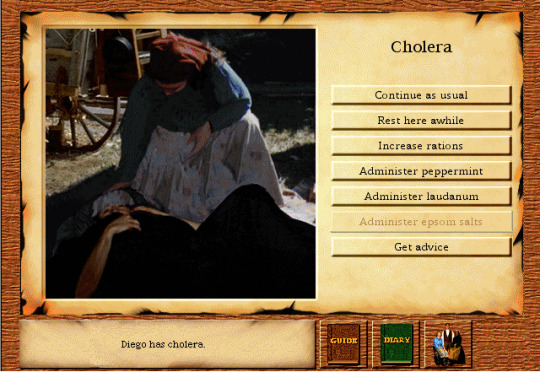
Spoiler alert! It was mostly about malnourishment and dysentery.
For those unfamiliar, The Oregon Trail was produced by the Minnesota Educational Computing Consortium, known by schoolchildren everywhere as MECC. The game was released for numerous platforms, including the Apple II, DOS computers, and the Atari 8-Bit platforms. Its popularity cannot be overstated. Such popularity led to releases to newer platforms, prompting updates to extend the game’s longevity. The Apple II version eventually gave way to the Macintosh version, the DOS version likewise was retired in favor of Windows.
Updating an educational piece of software like The Oregon Trail seems like the perfect strategy for perpetual sales. The historical framework that the game is centered on doesn’t change, but could easily be adapted into more modern forms of video game storytelling, allowing kids to get a better and better representation of what the endeavor might have been like. Simply updating the game and re-releasing it would seem like a practical inevitability, just as the math in textbooks doesn’t change, but new editions keep being made anyway to feed the publishing industry monster, whose thirst for paper is insatiable.
MECC did keep up releasing Oregon Trail for as long as it could. Interestingly, though, somewhere along the line, they got the idea in their head that putting a new paint job on the game and slapping that classic logo on the box just wasn’t quite enough to keep interest up. No, fueled by the lust for the dollars that sequels bring, MECC decided they were going to make Oregon Trail II. I know what you’re thinking: “How on earth could MECC top their greatest creation?” Or maybe you’re more realistically thinking “How can you create a sequel to a historical event?” Let me tell you how.
Oregon Trail II: The Oregoning (if only) is the exact same game as its predecessor in just about every meaningful way. What exactly was the difference, then? Why, oh why did this thing need to be brought into the world? The CD-ROM, of course. CD-ROM technology ushered in a revolution of adoption for computers. For a multitude of reasons I don’t have the time nor expertise to suss out here, CD-ROMs fundamentally altered how the public thought about computers and their utility. At the heart of it seems to be that the data storage capacity of these optical discs meant computers could render more convincing and realistic worlds to the masses, making computers less mysterious and threatening, and much more inviting, like a VCR.
CD-ROMs meant that encyclopedic knowledge could suddenly be stored and accessed not in heavy and annoying to thumb through books, but rather on light and easily searchable programs loaded from the disc. Looking back, this all seems a bit quaint, but it was very exciting for the time. This was before the internet had become such a staple of modern life, so having easy access to lots of data via compact disc was very attractive and opened a lot of possibilities. These possibilities were especially attractive to game makers. Remember, it was the compact disc that caused Squaresoft to jump ship from Nintendo to Sony, giving us Final Fantasy VII. To date, there has not been a superior invention. In any case, MECC, like Squaresoft (only two years before Squaresoft), saw the potential of CDs to really give their tried and true Oregon Trail a kick in the pants.
While the hype was literally unreal for this sequel, we do have to be real about it. Oregon Trail II is almost exactly like The Oregon Trail. Nearly every change is superficial in nature, but those superficial changes apply to essentially every aspect of the game’s presentation. The first thing players will notice is that Oregon Trail II has a full musical score, and, depending on your taste, that score kicks ass. Music of this quantity and quality was simply not possible on this scale before CD-ROMs had become the main platform for computer games. Along with the music, the game features numerous voice samples, which add a nice element to the various characters that the player can interact with over the course of their journey. While text works just fine, let’s face it, having the words spoken to you makes it both easier and faster to understand. While I wouldn’t say the actors are stellar, for an educational game, they are perfectly adequate, on par with what you’d get visiting a historical re-enactment of some kind.
Graphically, the game received a huge upgrade as well. Digitized actors were placed in the game, making the re-enactment comparison that much stronger. In the beginning of the game you can explore the town adventure game style with each location being a single scene populated with various NPCs. While hopelessly dated by modern standard, it would be difficult to say that in 1995, this didn’t seriously enhance the immersion that the game was going for. What was just a simple screen where you input numerical values for the supplies you wanted became a place you could explore, which is always nice.
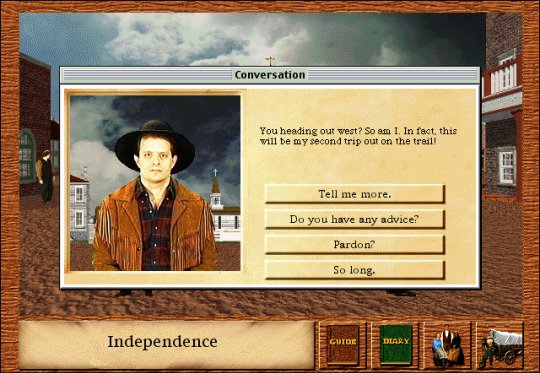
This actor’s face says “No amount of money is worth this.”
The player is faced with multiple choices they must make in order to make their trip to the West successful. Lots of unexpected events will take place, such as oxen dying, yokes breaking, people getting ill or lost. Whenever hardship falls upon your party, you must make a decision regarding how you will proceed, and your choices affect what happens next. You’re not alone, however, as the people you travel with can be consulted, adding an extra dimension to the experience.
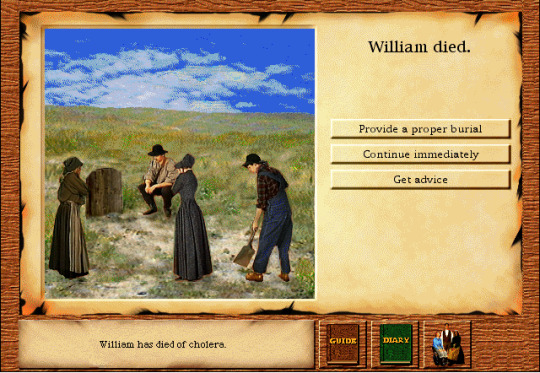
Not sure how we could continue immediately when we’ve already buried him.
The most useful update came in the form of the map that would fill the screen as the player made their way across the trail. It is a highly detailed map, which gives both an incredibly accurate reading of where you are at any given time, but also helps set in the scale of this journey. In the Apple II days, it was admittedly a bit difficult to get a sense of just how grueling this journey must have been. Sure, all your party members were likely to die horrible deaths along the way, but that occurred around a nice animation of oxen walking. Oregon Trail II feels much more traditionally educational with it’s map tracking, but seeing the topography of the area and watching as you make your way from one side of the map to the other, only to have it adjust to a whole new section of map hammers home the fact that this trip was insane.
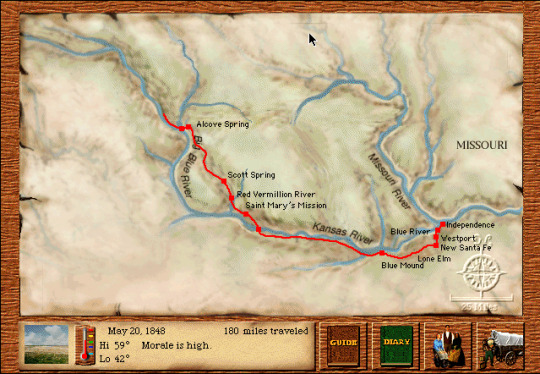
Ultimately, the wow factor of CD-ROM technology did not make Oregon Trail II the runaway success that The Oregon Trail had been. I’m pretty sure the only reason I played it back in 1995 was because my parents taught elementary school, and thus my home was full of all kinds of education software. On a personal level, I absolutely loved this game, even more so than the original. I’m aware, however, that it had no real chance of supplanting the classic that defined edutainment for so long. Something as iconic as The Oregon Trail is a rarity in any medium or industry, and it would be foolish to think that repackaging something and calling it a sequel could have the same impact. Whether or not the good people at MECC thought it would, I have no idea, but I’m glad they went ahead and made it, anyway, if for nothing else then to hear the Trail theme go from upbeat to more and more frantic and ominous as my party inches closer and closer to California, and cholera, and measles.
6 notes
·
View notes